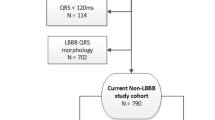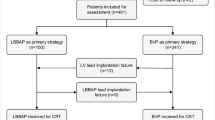Abstract
Objective
In MADIT-CRT, patients with non-LBBB (right bundle branch block or nonspecific ventricular conduction delay) and a prolonged PR-interval derived significant clinical benefit from cardiac resynchronization therapy with defibrillator (CRT-D) compared to an implantable cardioverter defibrillator (ICD)-only. We aimed to study the long-term outcome of non-LBBB patients by baseline PR-interval with CRT-D versus ICD-only.
Methods
Non-LBBB patients (n = 534) were dichotomized based on baseline PR-interval: normal PR (PR < 230 ms), and markedly prolonged PR (PR ≥ 230 ms). The primary end point was heart failure (HF) or death. Secondary end points were HF only and all-cause death.
Results
In patients with a prolonged PR-interval, CRT-D treatment related to a 67 % significant reduction in the risk of HF/death (HR = 0.33, 95 % CI 0.16–0.69, p = 0.003), 69 % decrease in HF (HR = 0.31, 95 % CI 0.14–0.68, p = 0.003), and 76 % reduction in the risk of death (HR = 0.24, 95 % CI 0.07–0.80, p = 0.020) compared to ICD-only (median follow-up 5.8 years). In normal PR-interval patients, CRT-D therapy was associated with a trend towards increased risk of HF/death (HR = 1.49, 95 % CI 0.98–2.25, p = 0.061), and significantly increased mortality (HR = 2.27, 95 % CI 1.16–4.44, p = 0.014). Significant statistical interaction with the PR-interval was demonstrated for all end points. Results were consistent for QRS 130–150 ms and QRS > 150 ms.
Conclusion
In MADIT-CRT, non-LBBB patients with a prolonged PR-interval derive sustained long-term clinical benefit with reductions in heart failure or death from CRT-D implantation, compared to an ICD-only. Our findings support implantation of CRT-D in non-LBBB patients with prolonged PR-interval irrespective of baseline QRS duration.



Similar content being viewed by others
References
Moss AJ, Hall WJ, Cannom DS, Klein H, Brown MW, Daubert JP, Estes NA 3rd, Foster E, Greenberg H, Higgins SL, Pfeffer MA, Solomon SD, Wilber D, Zareba W, Trial Investigators MADIT-CRT (2009) Cardiac-resynchronization therapy for the prevention of heart-failure events. N Engl J Med 361(14):1329–1338
Zareba W, Klein H, Cygankiewicz I, Hall WJ, McNitt S, Brown M, Cannom D, Daubert JP, Eldar M, Gold MR, Goldberger JJ, Goldenberg I, Lichstein E, Pitschner H, Rashtian M, Solomon S, Viskin S, Wang P, Moss AJ, Investigators MADIT-CRT (2011) Effectiveness of cardiac resynchronization therapy by QRS morphology in the multicenter automatic defibrillator implantation trial-cardiac resynchronization therapy (MADIT-CRT). Circulation 123(10):1061–1072
Goldenberg I, Kutyifa V, Klein HU, Cannom DS, Brown MW, Dan A, Daubert JP, Estes NA 3rd, Foster E, Greenberg H, Kautzner J, Klempfner R, Kuniss M, Merkely B, Pfeffer MA, Quesada A, Viskin S, McNitt S, Polonsky B, Ghanem A, Solomon SD, Wilber D, Zareba W, Moss AJ (2014) Survival with cardiac-resynchronization therapy in mild heart failure. N Engl J Med 370(18):1694–1701
Kutyifa V, Stockburger M, Daubert JP, Holmqvist F, Olshansky B, Schuger C, Klein H, Goldenberg I, Brenyo A, McNitt S, Merkely B, Zareba W, Moss AJ (2014) PR-interval identifies clinical response in patients with non-left bundle branch block: a multicenter automatic defibrillator implantation trial-cardiac resynchronization therapy substudy. Circ Arrhythm Electrophysiol 7(4):645–651
Brignole M, Auricchio A, Baron-Esquivias G, Bordachar P, Boriani G, Breithardt OA, Cleland J, Deharo JC, Delgado V, Elliott PM, Gorenek B, Israel CW, Leclercq C, Linde C, Mont L, Padeletti L, Sutton R, Vardas PE, ESC Committee for Practice Guidelines (CPG), Zamorano JL, Achenbach S, Baumgartner H, Bax JJ, Bueno H, Dean V, Deaton C, Erol C, Fagard R, Ferrari R, Hasdai D, Hoes AW, Kirchhof P, Knuuti J, Kolh P, Lancellotti P, Linhart A, Nihoyannopoulos P, Piepoli MF, Ponikowski P, Sirnes PA, Tamargo JL, Tendera M, Torbicki A, Wijns W, Windecker S, Document Reviewers, Kirchhof P, Blomstrom-Lundqvist C, Badano LP, Aliyev F, Bänsch D, Baumgartner H, Bsata W, Buser P, Charron P, Daubert JC, Dobreanu D, Faerestrand S, Hasdai D, Hoes AW, Le Heuzey JY, Mavrakis H, McDonagh T, Merino JL, Nawar MM, Nielsen JC, Pieske B, Poposka L, Ruschitzka F, Tendera M, Van Gelder IC, Wilson CM (2013) 2013 ESC Guidelines on cardiac pacing and cardiac resynchronization therapy: the Task Force on cardiac pacing and resynchronization therapy of the European Society of Cardiology (ESC). Developed in collaboration with the European Heart Rhythm Association (EHRA). Eur Heart J 34:2281–2329
Tang AS, Wells GA, Talajic M, Arnold MO, Sheldon R, Connolly S, Hohnloser SH, Nichol G, Birnie DH, Sapp JL, Yee R, Healey JS, Rouleau JL (2010) Resynchronization-Defibrillation for Ambulatory Heart Failure Trial Investigators. Cardiac-resynchronization therapy for mild-to-moderate heart failure. N Engl J Med 363(25):2385–2395
Gold MR, Thébault C, Linde C, Abraham WT, Gerritse B, Ghio S, St John Sutton M, Daubert JC (2012) Effect of QRS duration and morphology on cardiac resynchronization therapy outcomes in mild heart failure: results from the Resynchronization Reverses Remodeling in Systolic Left Ventricular Dysfunction (REVERSE) study. Circulation 126(7):822–829
Birnie DH, Ha A, Higginson L, Sidhu K, Green M, Philippon F, Thibault B, Wells G, Tang A (2013) Impact of QRS morphology and duration on outcomes after cardiac resynchronization therapy: results from the Resynchronization-Defibrillation for Ambulatory Heart Failure Trial (RAFT). Circ Heart Fail 6(6):1190–1198
Moss AJ, Brown MW, Cannom DS, Daubert JP, Estes M, Foster E, Greenberg HM, Hall WJ, Higgins SL, Klein H, Pfeffer M, Wilber D, Zareba W (2005) Multicenter automatic defibrillator implantation trial-cardiac resynchronization therapy (MADIT-CRT): design and clinical protocol. Ann Noninvasive Electrocardiol 10(4 Suppl):34–43
Willems JL, Robles de Medina EO, Bernard R, Coumel P, Fisch C, Krikler D, Mazur NA, Meijler FL, Mogensen L, Moret P, Pisa Z, Rautaharju PM, Surawicz B, Watanabe Y, Wellens HJJ (1985) Criteria for intraventricular conduction disturbances and pre-excitation. World Health Organizational/International Society and Federation for Cardiology Task Force Ad Hoc. J Am Coll Cardiol 5(6):1261–1275
Schoeller R, Andresen D, Buttner P, Oezcelik K, Vey G, Schroder R (1993) First- or second-degree atrioventricular block as a risk factor in idiopathic dilated cardiomyopathy. Am J Cardiol 71(8):720–726
Olshansky B, Day JD, Sullivan RM, Yong P, Galle E, Steinberg JS (2012) Does cardiac resynchronization therapy provide unrecognized benefit in patients with prolonged PR-intervals? The impact of restoring atrioventricular synchrony: an analysis from the COMPANION Trial. Heart Rhythm 9(1):34–39
Cheng S, Keyes MJ, Larson MG, McCabe EL, Newton-Cheh C, Levy D, Benjamin EJ, Vasan RS, Wang TJ (2009) Long-term outcomes in individuals with prolonged PR-interval or first-degree atrioventricular block. JAMA 301(24):2571–2577
Hochleitner M, Hörtnagl H, Ng CK, Hörtnagl H, Gschnitzer F, Zechmann W (1990) Usefulness of physiologic dual-chamber pacing in drug-resistant idiopathic dilated cardiomyopathy. Am J Cardiol 66:198–202
Hochleitner M, Hörtnagl H, Hörtnagl H, Fridrich L, Gschnitzer F (1992) Long-term efficacy of physiologic dual-chamber pacing in the treatment of end-stage idiopathic dilated cardiomyopathy. Am J Cardiol 70(15):1320–1325
Kloosterman M, Rienstra M, Mulder BA, Van Gelder IC, Maass AH (2015) Atrial reverse remodelling is associated with outcome of cardiac resynchronization therapy. Europace (Epub ahead of print)
Ruschitzka F, Abraham WT, Singh JP, Bax JJ, Borer JS, Brugada J, Dickstein K, Ford I, Gorcsan J 3rd, Gras D, Krum H, Sogaard P, Holzmeister J, EchoCRT Study Group (2013) Cardiac-resynchronization therapy in heart failure with a narrow QRS complex. N Engl J Med 369(15):1395–1405
Hürlimann D, Schmidt S, Seifert B, Saguner AM, Hindricks G, Lüscher TF, Ruschitzka F, Steffel J (2015) Outcome of super-responders to cardiac resynchronization therapy defined by endpoint-derived parameters of left ventricular remodeling: a two-center retrospective study. Clin Res Cardiol. 104(2):136–144
Franke J, Keppler J, Abadei AK, Bajrovic A, Meme L, Zugck C, Raake PW, Zitron E, Katus HA, Frankenstein L (2016) Long-term outcome of patients with and without super-response to CRT-D. Clin Res Cardiol 105(4):341–348
Acknowledgments
We are grateful to the patients, the study centers in the U.S., Europe, Israel and enrolling physicians for their commitment to the multicenter automatic defibrillator implantation trial-cardiac resynchronization therapy (MADIT-CRT) study. We thank the very valuable contribution of our programmer Bronislava Polonsky, from the University of Rochester for her assistance and SAS macros for the clinical characteristics and graphs in the present analysis.
Author information
Authors and Affiliations
Corresponding author
Ethics declarations
Conflict of interest
M. Stockburger: research grant from Boston Scientific, Sorin Group and Zoll and speaker’s honoraria from Medtronic.V. Kutyifa: research grant from Boston Scientific and Zoll.H. U. Klein: research grant from Boston Scientific and Zoll.AJ Moss, W. Zareba, I. Goldenberg, Y. Biton: research grant from Boston Scientific.
Funding source
This substudy of MADIT-CRT did not receive specific funding. The main trial has been conducted by the Heart Research Follow-up Program (University of Rochester Medical Center), Supported by Boston Scientific Inc.
Additional information
On behalf of the MADIT-CRT Executive Committee.
Rights and permissions
About this article
Cite this article
Stockburger, M., Moss, A.J., Klein, H.U. et al. Sustained clinical benefit of cardiac resynchronization therapy in non-LBBB patients with prolonged PR-interval: MADIT-CRT long-term follow-up. Clin Res Cardiol 105, 944–952 (2016). https://doi.org/10.1007/s00392-016-1003-z
Received:
Accepted:
Published:
Issue Date:
DOI: https://doi.org/10.1007/s00392-016-1003-z




